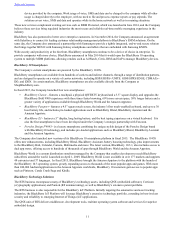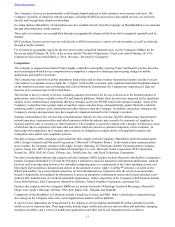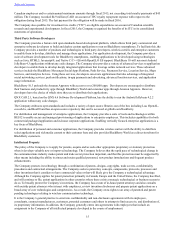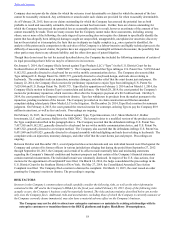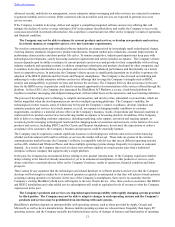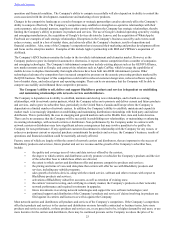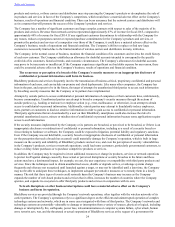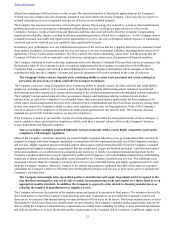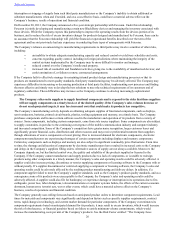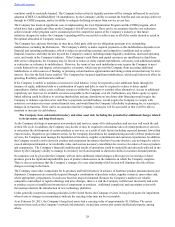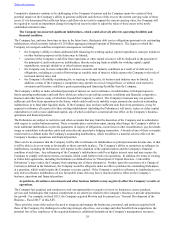Blackberry 2015 Annual Report Download - page 28
Download and view the complete annual report
Please find page 28 of the 2015 Blackberry annual report below. You can navigate through the pages in the report by either clicking on the pages listed below, or by using the keyword search tool below to find specific information within the annual report.
Table of Contents
19
The Company’s current focus is on serving enterprise customers, particularly in regulated industries, including financial
services, government and healthcare. In fiscal 2015, the Company undertook numerous initiatives to attract and retain
enterprise customers. Throughout much of the year, the Company operated an EZ Pass program that enabled customers to
easily move from BES and competitors' MDM platforms to BES10 or BES12. The Company experienced strong demand for
the program, with many licenses traded in from competitors' MDM platforms and overall uptake exceeding the Company's
goals. As a result, the Company ended the EZ Pass registrations in December 2014, shortly after the launch of BES12, the
Company's flagship EMM solution supporting all major mobile platforms, including BlackBerry 10 and BBOS 7. In fiscal
2015, the Company also launched value-added cross-platform enterprise solutions, including BlackBerry Blend, BBM
Protected, BBM Meetings, WorkLife by BlackBerry, Enterprise Identity by BlackBerry and VPN Authentication by
BlackBerry. The enterprise-focused Classic and Passport smartphones were also introduced during the year, together with f
BES10 Hosted and BES12 Hosted. The Company also announced a strategic partnership with Samsung that is expected to
bring together BES12 with Samsung Galaxy smartphones and tablets that are embedded with Samsung KNOX. If the
Company’s new products are not competitive, do not align with customers' needs, are not launched as per the announced
timeline or if they experience quality or performance issues, results of operations could be materially impacted.
While the Company expects these initiatives to improve and enhance its strength in enterprise solutions, there can be no
assurance that new enterprise customers will be attracted or existing ones maintained. In addition, there can be no assurance
that BES12 installations and value-added service subscriptions will result in equivalent levels of revenue to what the Company
experienced in the past. The Company also faces the risk that certain enterprise customers may not upgrade to the Gold level of
service from the free Silver level of service that was offered by the Company as part of its EZ Pass program, and the risk that
customers will not renew their annual subscriptions. See also the Risk Factor entitled “The Company may not be able to
develop, market and distribute an integrated software and services offering, or otherwise monetize its technologies, to grow
revenue, achieve sustained profitability or mitigate the impact of the decline in the Company's service access fees”.
Sales to large enterprise customers involve risks that may not be present (or that are present to a lesser extent) with sales to
smaller entities. These risks include:
• more complicated infrastructure requirements, which result in more difficult and time-consuming implementation
processes;
• more intense and time-consuming customer support practices;
• increased purchasing power and leverage held by large customers in negotiating contractual arrangements with the
Company, including more pressure for discounts;
• more customer-favourable contractual terms, including penalties;
• longer sales cycles and the associated risk that substantial time and resources may be spent on a potential customer
that ultimately elects not to purchase the Company’s products or services, or purchases fewer products or services than
expected; and
• closer relationships with, and dependence upon, large technology companies that offer competitive solutions.
If the Company is unable to increase sales of the Company’s products and services to large enterprises while mitigating the
risks associated with serving such customers, the Company’s results of operations could be materially impacted.
Many of the Company’s large enterprise customers have very complex IT systems, mobile environments and data privacy and
security requirements. Accordingly, these customers typically undertake a significant evaluation process, which frequently
involves not only the Company’s products and services, but also those of the Company's competitors, and can result in a
lengthy sales cycle. The Company spends substantial time, money and effort on its sales activities without any assurance that its
efforts will produce any sales. In addition, purchases of the Company’s products and services are frequently subject to budget
constraints, multiple approvals, lengthy contract negotiations, and unplanned administrative, processing and other delays.
Moreover, the evolving nature of the wireless communications market may lead prospective customers to postpone their
purchasing decisions pending adoption of technology by others or pending potential consolidation in the market. As a result of
the lengthy enterprise sales cycle, it is difficult to predict whether and when a sale will be completed, and the Company’s
operating results may vary significantly from quarter to quarter. Even if sales are completed, the revenues the Company
receives from these customers may not be sufficient to offset BlackBerry’s upfront investments.
Finally, the Company has encountered challenges due to the impact of BYOD strategies being adopted by its enterprise
customers, as many IT departments that previously required employees to use the BlackBerry wireless solution because of its
emphasis on security and reliability are permitting employees to choose devices offered by the Company’s competitors, and this
has been reflected through a decrease in the Company’s enterprise subscribers. To address this evolution of the market, the
Company has introduced new cross-platform solutions and new, more competitive BlackBerry smartphones, as noted above.
The Company will also continue to seek partnerships that will further enable the Company to enhance these and potentially
other offerings. However, there can be no assurance that these new product offerings will enable the Company to successfully
address the challenges it faces from the trend toward flexible mobile deployment models in the enterprise space, either with
existing or new customers.




